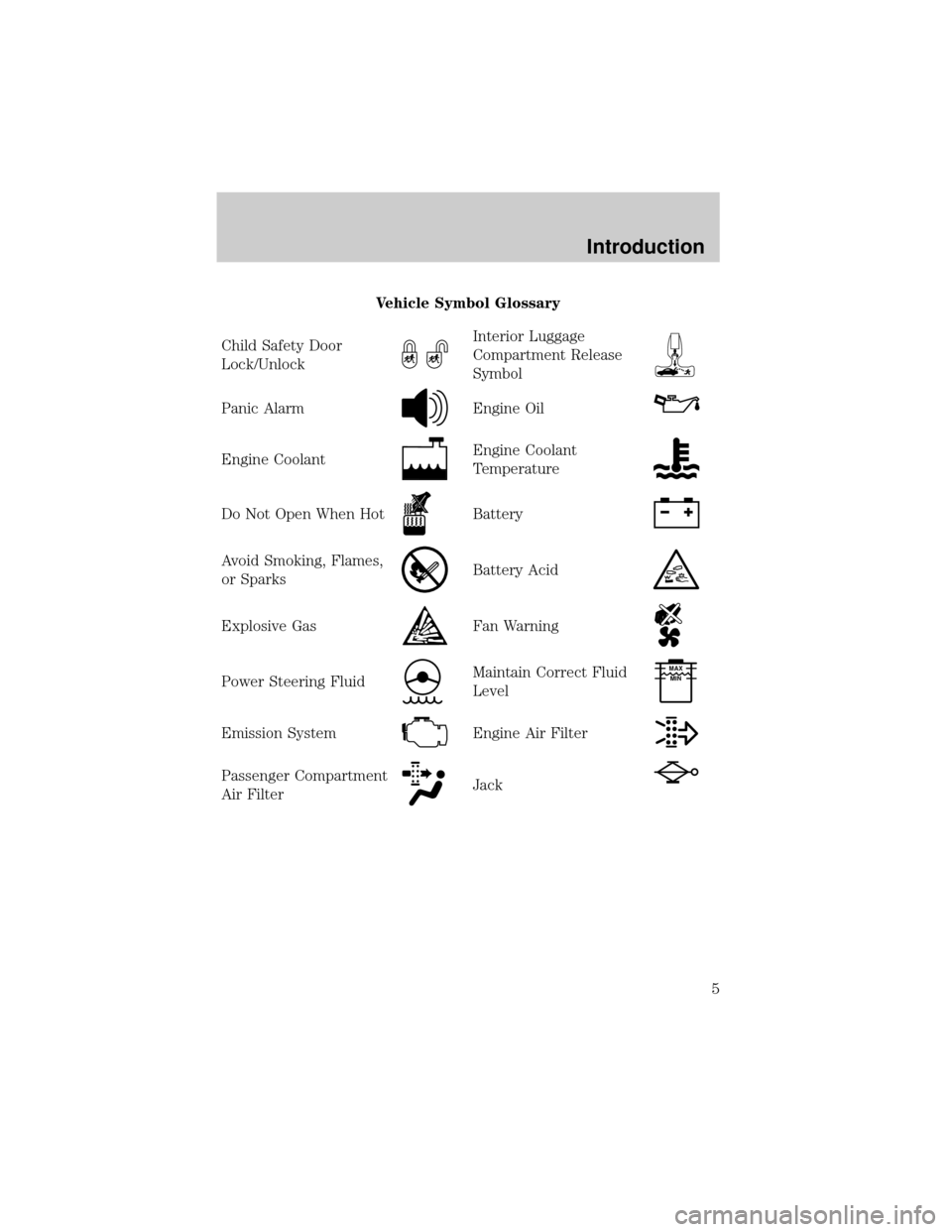2000 LINCOLN CONTINENTAL coolant temperature
[x] Cancel search: coolant temperaturePage 5 of 232

Vehicle Symbol Glossary
Child Safety Door
Lock/Unlock
Interior Luggage
Compartment Release
Symbol
Panic AlarmEngine Oil
Engine CoolantEngine Coolant
Temperature
Do Not Open When HotBattery
Avoid Smoking, Flames,
or SparksBattery Acid
Explosive GasFan Warning
Power Steering FluidMaintain Correct Fluid
LevelMAX
MIN
Emission SystemEngine Air Filter
Passenger Compartment
Air FilterJack
Introduction
5
Page 13 of 232

Speedometer
Indicates the current vehicle speed.
Odometer
The odometer is located in the message center. It registers the total
kilometers (miles) of the vehicle. Pressing the E/M control (if equipped)
will alternate between English (miles) and Metric (kilometers)
measurements.
Tachometer
Indicates the engine speed in
revolutions per minute.
Driving with your tachometer
pointer in the red zone may damage
the engine.
Engine coolant temperature gauge
Indicates the temperature of the
engine coolant. At normal operating
temperature, the needle remains
within the normal area (the area
between the ªHº and ªCº). If it
enters the red section, the engine is
overheating. Stop the vehicle as
soon as safely possible, switch off
the engine immediately and let the
engine cool. Refer toEngine
coolantin theMaintenance and carechapter.
Never remove the coolant reservoir cap while the engine is
running or hot.
80
MPH km/h0 2060
80
100
1200 204060100
120
140
160
180
200
40
ABS
RPMx1000AIR
BAG0 123456
7
NORM
CH
Instrumentation
13
Page 14 of 232

This gauge indicates the temperature of the engine coolant, not the
coolant level. If the coolant is not at its proper level the gauge indication
will not be accurate.
ELECTRONIC MESSAGE CENTER
The electronic message center only
works when the ignition is in the
ON position.
The message center tells you about
the condition of your vehicle by two
methods:
²operator selectable features
²continuous warning reporting of
monitored systems
You can select different features for
the message center to display by
using the message center controls
located to the right of the instrument
cluster. You will hear a tone when you press one of these controls.
However, the message center will display the appropriate warning message
if it detects a warning from any of the monitored systems.
If you have a vehicle with the Driver
Select System, which allows you to
save operator selectable features to
DRIVER 1 or DRIVER 2, you have a
DRIVER ID control in place of the E/M control.
The message center will display theMemory Profile Systemfeatures
(operator selectable features) which are selected from the MENU and
VEHICLE HANDLING controls.
The Memory Profile System allows for two primary drivers to save their
individual seat and outside rearview mirror position preferences. The
feature will then be set to the remote entry transmitter, that will
automatically recall the saved individualized preferences. Refer toBasic
Operation of Memory Profile Systemin this section.
SYSTEM
E/M
MENU
TRIP
RESETSELECT
DISPLAY
DTE ECON VEHICLE HANDLING
DRIVER ID
Instrumentation
14
Page 122 of 232

Make sure the corresponding lights illuminate briefly. If a light fails to
illuminate, have the vehicle serviced.
²If the driver's safety belt is fastened, the
light may not illuminate.
STARTING THE ENGINE
1. Turn the key to 5 (START)
without pressing the accelerator
pedal and release as soon as the
engine starts. The key will return to
4 (ON).
2. If the temperature is above ±12ÉC
(10ÉF) and the engine does not
start within five seconds on the first
try, turn the key to OFF, wait 10
seconds and try again.
3. If the temperature is below -12É C (10É F) and the engine does not
start in 15 seconds on the first try, turn the key OFF and wait 10
seconds and try again. If the engine does not start in two attempts, Press
the accelerator pedal all the way to floor and hold. Turn the key to
START position.
4. When the engine starts, release the key, then release the accelerator
pedal gradually as the engine speeds up.
5. After idling for a few seconds, apply the brake and release the parking
brake.
Using the engine block heater (if equipped)
An engine block heater warms the engine coolant, which improves
starting, warms up the engine faster and allows the heater-defroster
system to respond quickly. Use of an engine block heater is strongly
80
MPH km/h
ABS
P!BRAKE
+ –
RPMx1000NORM
T/C
OFF
CHEF
FILL ON RIGHT
SERVICE
ENGINE
SOON AIR
BAG TURN ON
HEAD
LAMPS0 123456
7
0 2060
80
100
120
0 204060100
120
140
160
180
200
40
000000.0
P R N D 3 1
3
2
1
5
4
Starting
122
Page 173 of 232

Coolant refill capacity
To find out how much fluid your vehicle's cooling system can hold, refer
toRefill capacitiesin theCapacities and specificationschapter.
Fill your engine coolant reservoir as outlined inAdding engine coolant
in this chapter.
Severe climates
If you drive in extremely cold climates (less than ±36É C [±34É F]):
²it may be necessary to increase the coolant concentration
above 50%.
²NEVER increase the coolant concentration above 60%.
²increased engine coolant concentrations above 60% will
decrease the overheat protection characteristics of the engine
coolant and may cause engine damage.
²refer to the chart on the coolant container to ensure the
coolant concentration in your vehicle will provide adequate
freeze protection at the temperatures in which you drive in the
winter months.
If you drive in extremely hot climates:
²it is still necessary to maintain the coolant concentration
above 40%.
²NEVER decrease the coolant concentration below 40%.
²decreased engine coolant concentrations below 40% will
decrease the corrosion protection characteristics of the engine
coolant and may cause engine damage.
²decreased engine coolant concentrations below 40% will
decrease the freeze protection characteristics of the engine
coolant and may cause engine damage.
²refer to the chart on the coolant container to ensure the
coolant concentration in your vehicle will provide adequate
protection at the temperatures in which you drive.
Vehicles driven year-round in non-extreme climates should use a 50/50
mixture of engine coolant and distilled water for optimum cooling system
and engine protection.
Maintenance and care
173
Page 174 of 232

CHECKING AND ADDING POWER STEERING FLUID
Check the power steering fluid.
Refer to the Scheduled Maintenance
Guide for the service interval
schedules. If adding fluid is
necessary, use only MERCONtAT F.
1. Start the engine and let it run until it reaches normal operating
temperature (the engine coolant temperature gauge indicator will be
near the center of the normal area between H and C).
2. While the engine idles, turn the steering wheel left and right several
times.
3. Turn the engine off.
4. Check the fluid level in the
reservoir. It should be between the
MIN and MAX lines. Do not add
fluid if the level is in this range.
5. If the fluid is low, add fluid in small amounts, continuously checking
the level until it reaches the range between the MIN and MAX lines. Be
sure to put the cap back on the reservoir.
TRANSMISSION FLUID
Checking automatic transmission fluid
Refer to your Scheduled Maintenance Guide for scheduled intervals for
fluid checks and changes. Your transaxle does not consume fluid.
However, the fluid level should be checked if the transaxle is not working
properly, i.e., if the transaxle slips or shifts slowly or if you notice some
sign of fluid leakage.
Maintenance and care
174
Page 226 of 232

Accessory delay ..........................76
Air bag supplemental
restraint system ..........104,105,109
and child safety seats ............106
description .......................105,109
disposal ....................................112
driver air bag ...................107,110
indicator light ...............9,108,111
operation ..........................107,110
passenger air bag ............107,110
side air bag ..............................109
Air cleaner filter .......................209
Air conditioning ..........................24
automatic temperature
control system ..........................24
Air filter, cabin ..........................179
Air suspension ...........................129
description ..............................129
Antifreeze
(see Engine coolant) ................169
Anti-lock brake system
(see Brakes) .......................125,126
Anti-theft system ........................79
arming the system ....................79
disarming a triggered system ..80
Audio system (see Radio) .........30
Automatic transaxle .................130
driving with .............................132
fluid, adding ............................174
fluid, checking ........................174
fluid, refill capacities ..............209
fluid, specification ..................211
Axle
lubricant specifications ..........210
Battery .......................................177
acid, treating emergencies .....177
charging system
warning light .............................11
jumping a disabled battery ....156
maintenance-free ....................177
replacement, specifications ...209
servicing ..................................177Belt minder ...............................100
Brakes ........................................125
anti-lock ............................125,126
anti-lock brake system
(ABS) warning light ..........10,126
brake warning light ..................10
fluid, checking and adding ....168
fluid, refill capacities ..............209
fluid, specifications ..........210,211
lubricant specifications ...210,211
shift interlock ..........................130
Break-in period .............................3
Capacities for refilling fluids ....209
CD changer .................................42
Certification Label ....................213
Child safety restraints ..............112
child safety belts ....................112
Child safety seats ......................113
attaching with tether straps ..117
in front seat ............................115
in rear seat ..............................115
Cleaning your vehicle ...............204
engine compartment ..............206
exterior ....................................205
exterior lamps .........................206
instrument panel ....................207
instrument panel lens ............207
interior ..............................207,208
mirrors .....................................205
plastic parts ............................205
safety belts ..............................208
washing ....................................204
waxing .....................................204
wheels ......................................205
windows ..................................208
wiper blades ............................206
woodtone trim ........................208
Climate control (see Air
conditioning or Heating) ............24
Clock ............................................30
Compass, electronic ....................69
calibration ............................71,73
Index
226
Page 228 of 232

gauge .........................................12
improving fuel economy ........192
octane rating ....................190,211
quality ......................................190
running out of fuel .................191
safety information relating to
automotive fuels .....................187
Fuses ...................................143,144
Garage door opener ....................65
Gas cap (see Fuel cap) ............189
Gas mileage
(see Fuel economy) .................192
Gauges .........................................12
engine coolant
temperature gauge ...................13
fuel gauge ..................................12
odometer ...................................13
speedometer .............................13
tachometer ................................13
GAWR
(Gross Axle Weight Rating) .....135
definition .................................135
driving with a heavy load ......135
location ....................................135
GVWR (Gross
Vehicle Weight Rating) .............135
calculating ...............................135
definition .................................135
driving with a heavy load ......135
location ....................................135
Hazard flashers .........................142
Head restraints ...........................92
Headlamps ...................................22
aiming ........................201,202,203
autolamp system .......................23
bulb specifications ..................201
daytime running lights .............22
flash to pass ..............................23
high beam ............................10,22
replacing bulbs .......................197
turning on and off ...............11,22
warning chime ..........................12Heating ........................................24
HomeLink universal
transceiver (see Garage
door opener) ................65,66,67,68
Hood ..........................................163
Ignition .......................................211
positions of the ignition ...........46
Infant seats
(see Safety seats) .....................113
Inspection/maintenance
(I/M) testing ..............................196
Instrument panel
cleaning ...................................207
cluster ...................................8,207
lighting up
panel and interior .....................23
location of components ..............8
Jump-starting your vehicle ......156
Keyless entry system .................85
autolock .....................................88
keypad .......................................85
programming entry code .........86
Keys .............................................47
key in ignition chime ...............12
positions of the ignition ...........46
Lamps
autolamp system .......................23
bulb replacement
specifications chart ................201
cargo lamps ...............................23
daytime running light ...............22
headlamps .................................22
headlamps, flash to pass ..........23
instrument panel, dimming .....23
interior lamps ...............53,54,200
replacing bulbs ..196,197,199,200
Lane change indicator
(see Turn signal) ........................48
Lights, warning and indicator ......8
air bag ..........................................9
anti-lock brakes (ABS) .....10,126
brake ..........................................10
Index
228